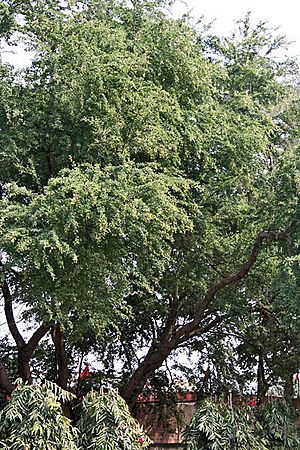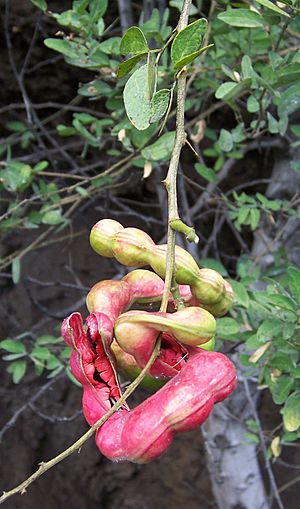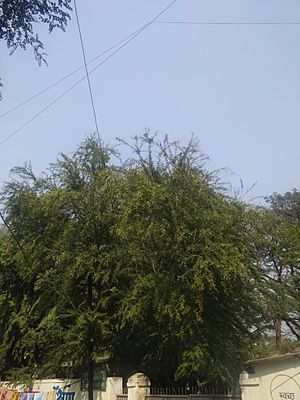Manila tamarind facts for kids
Quick facts for kids Manila tamarind |
|
|---|---|
 |
|
| In Kolkata, West Bengal (India) | |
 |
|
| Ripe Pithecellobium dulce bean | |
| Conservation status | |
| Scientific classification | |
| Genus: |
Pithecellobium
|
| Species: |
dulce
|
The Pithecellobium dulce, also known as Manila tamarind or Madras thorn, is a cool tree from the pea family. It's originally from places like Mexico, Central America, and northern South America. You might also hear it called monkeypod tree or camachile.
Even though it's from the Americas, this tree has traveled far! It was brought to places like the Philippines and Guam a long time ago by ships called Manila galleons. Now, you can find it growing naturally in the Caribbean, Florida, Thailand, and South Asia. In some places, like Hawaii, it grows so well that it's considered an invasive species, meaning it can sometimes take over areas where it's not native.
Contents
About the Manila Tamarind Tree
The Manila tamarind is a medium-sized tree that usually grows to be about 10 to 15 meters (around 33 to 49 feet) tall. Its trunk can be quite wide, and it often has spines.
Its leaves are special because they are "bipinnate." This means each leaf is divided into smaller parts, and those smaller parts are divided again into even tinier leaflets. Each leaflet is about 2 to 4 centimeters (about 1 to 1.5 inches) long.
The tree produces greenish-white, sweet-smelling flowers. These flowers grow into interesting pods that coil up. When a pod is ripe, it turns pink and opens up to show a pink or white, yummy pulp inside. This pulp covers shiny, flat, black seeds.
Birds love to eat the sweet pulp, and when they do, they help spread the seeds to new places. This tree is very tough and can grow in dry areas, even from sea level up to 1,500 meters (about 4,900 feet) high. This makes it a great tree to plant along streets!
Different Names for the Tree
The English names "Manila tamarind" and "Madras thorn" can be a bit confusing. The tree isn't actually related to the tamarind fruit, and it's not originally from Manila in the Philippines or Madras in India.
This tree has many different names around the world!
- In its home country of Mexico, people call it huamuche or guamúchil. These names come from the old Nahuatl language.
- When the tree came to the Philippines, its names also came from Nahuatl. In Tagalog, it's called kamachile, which is where the English name "camachile" comes from. In other Filipino languages, it's kamunsil (Hiligaynon) or damortis (Ilokano).
- In other parts of Latin America, it's known as pinzán or guamá americano. In Colombia, it's called chiminango.
- In Hawaiian, it's known as ʻopiuma.
- In South Asia and Southeast Asia, many names mean "foreign tamarind." For example:
In Pakistan, it's also called "jungle jalebi" because its pods look a bit like the sweet Indian snack called jalebi.
How People Use Manila Tamarind
As food
The pods of the Manila tamarind have a sweet and sour pulp inside. People in Mexico, the Philippines, Pakistan, and India often eat this pulp raw. It can be a tasty snack or served with meat dishes. Sometimes, people even make drinks from it by mixing the pulp with sugar and water.
Scientists have also looked into the seeds of the Manila tamarind. They've found that the seeds contain oil and a lot of protein. Some researchers think these seeds could be used in the future as food for animals.
In traditional practices
Different parts of the Manila tamarind tree have been used in traditional ways for a long time.
- In India, the bark was used to help with stomach problems.
- Some people in Mexico used parts of the tree to help with gum problems or toothache.
- The leaves were sometimes used to make a special paste with alcohol to help with certain body issues.
- The pulp from the fruits was also thought to help with some bleeding problems.
- Ground-up seeds have been used to help clean skin problems.
It's important to remember that these are traditional uses. If you have a health problem, it's always best to see a doctor.
The Tree's Role in Nature
The Manila tamarind tree is a very important plant for many insects. It acts as a "host plant" for the caterpillars of several types of butterflies and moths. This means the caterpillars eat its leaves and live on the tree as they grow. Some of these butterflies include the Common Nawab, the Three-spot Grass Yellow, and the Bright Babul Blue.
Images for kids
See also
 In Spanish: Rosca para niños
In Spanish: Rosca para niños





